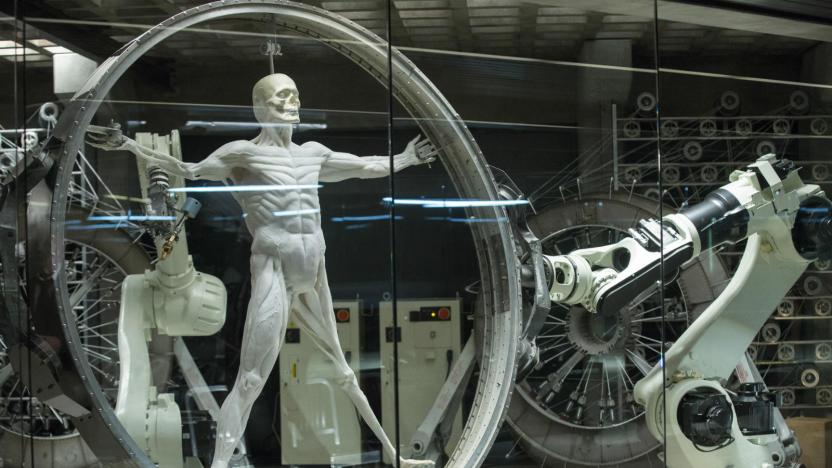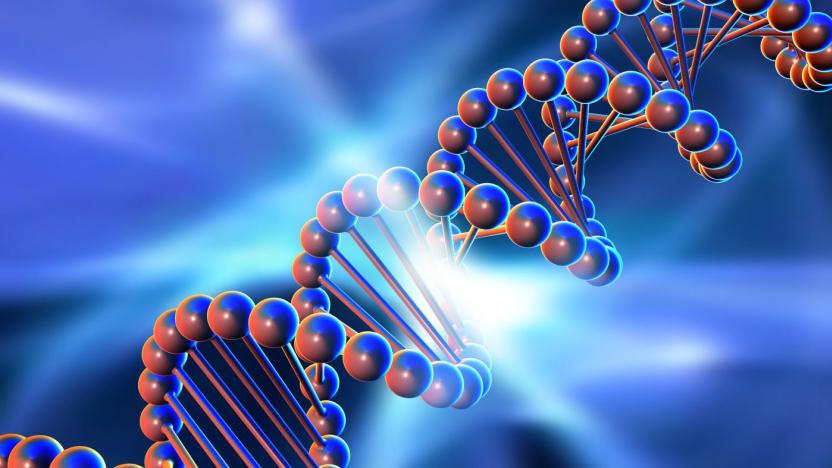synthetic
Latest

Scientists make a lifelike robotic fish using multipurpose 'blood'
There's no question that robots have come a long way since their cold, clunky, cumbersome inception. Nowadays they're smart, agile and responsive -- but they're still missing the tactile, multipurpose elements that make living creatures flexible and autonomous. Until now. In a bid to make robots more lifelike, scientists have created a soft robotic lionfish and have pumped it full of life-giving "blood."

Synthetic muscle breakthrough could lead to 'lifelike' robots
A breakthrough in soft robotics means scientists are now one step closer to creating lifelike machines. Researchers at Columbia Engineering have developed a 3D printed synthetic tissue that can act as active muscle. The material, which can push, pull, bend, and twist (thanks to its use of silicone rubber and ethanol-dispensing micro-bubbles) is also capable of carrying 1,000 times its own weight. Not only could the invention result in super-strong machines (like a Terminator that works in manufacturing), but it will also release soft robots from their current shackles.

MIT builds low-cost synthetic muscles out of nylon cord
Researchers have been trying to build durable, low-cost synthetic muscles for years but to no avail. The systems developed so far have either been too expensive to produce en mass (like carbon nanotube) or too delicate and power hungry (looking at you, shape-memory alloys) to be useful outside of laboratory conditions. But a team from MIT have just struck upon the Goldilocks zone of robo-muscles with nylon fiber of all things.

Scientists want to perfect humanity with synthetic DNA
Following a controversial top-secret meeting last month, a group of scientists have announced that they're working on synthesizing human genes from scratch. The project, currently titled HGP-Write, has the stated aim of reducing the cost of gene synthesis to "address a number of human health challenges." As the group explains, that includes growing replacement organs, engineering cancer resistance and building new vaccinations using human cells. But in order for all of that to happen, the scientists may have to also work on developing a blueprint for what a perfect human would look like.

ICYMI: Toilet tech, sight-giving headset & lab-grown veins
#fivemin-widget-blogsmith-image-185676{display:none;} .cke_show_borders #fivemin-widget-blogsmith-image-185676, #postcontentcontainer #fivemin-widget-blogsmith-image-185676{width:570px;display:block;} try{document.getElementById("fivemin-widget-blogsmith-image-185676").style.display="none";}catch(e){}Today on In Case You Missed It: Biosynthetic veins and arteries have been created by researchers in London that are able to imitate traits of human tissues, including the ability to self-heal. A headset designed for people with serious vision problems costs a hefty $15,000 but is able to modify sight for users by sending a tweaked for color and focus livestream of reality back to the display. And a Kickstarter gadget aims to tech out your toilet to actually smell okay rather than like... well you know.

Scientists close to brewing morphine (or heroin) from sugar
Sugar is basically ubiquitous and it looks like it could be used to make morphine, which is a refined form of heroin. Recent research shows that a genetically modified strain of yeast, when exposed to sugar, could be used to ferment the opioid. Yes, essentially, you could homebrew your own scag. I know what you're thinking: "This sounds like madness." But there's some proof behind it. Researchers from the University of California Berkeley and Concordia University in Canada presented an almost complete means to turn glucose to morphine, while scientists from the University of Calgary supplied the missing piece that completes the process. The idea wasn't to flood the streets with home-made heroin. No, the plan is much more noble than that: to produce "cheaper, less addictive, safer and more-effective" painkillers, according to Nature.

NYU synthesizes crystals with lifelike behavior under light
Scientists have long surmised that inorganic life is possible. New York University hasn't created any at this stage, but it just produced an uncannily close imitation through a recent experiment. When exposing hematite particles (iron and oxygen in a polymer) to specific wavelengths of blue light, researchers got the particles to form crystals that metabolize and move together like a flock. If it weren't for the lack of reproduction, the crystals would technically qualify as life -- and one upcoming test will trade mobility for that self-replication. Accordingly, NYU sees the crystals not just as having possible uses for electronics, but also as illustrating that a finer line might exist between living creatures and synthetic objects. Whether or not the university ever meets all three conditions for life at once, we may have to reset our expectations for what chemicals can do when they get together.

Robot skin captures super detailed 3D surface images
Remember those awesome pin art toys where you could press your hand (or face) into the pins to leaving a lasting impression? Researchers at MIT have taken the idea one (or two) steps further with "GelSight," a hunk of synthetic rubber that creates a detailed computer visualized image of whatever surface you press it against. It works as such: push the reflective side of the gummy against an object (they chose a chicken feather and a $20 bill) and the camera on the other end will capture a 3-D image of the microscopic surface structure. Originally designed as robot "skin," researchers realized the tool could be used in applications from criminal forensics (think bullets and fingerprints) to dermatology. The Coke can-sized machine is so sensitive, it can capture surface subtleties as small as one by two micrometer in surface -- finally solving the mystery of who stole the cookies from the cookie jar. (Hint: we know it was you Velvet Sledgehammer).

Researchers develop sticky gecko-like material
Researchers at BAE Systems' Advanced Technology Centre in Bristol seem to have take a cue from Q's play book, developing a new synthetic material that could be used to create special wall-climbing suits for soldiers and spies. The material is designed to mimic a gecko's foot, which is covered with hairs so small that they form a bond with just about anything they touch, but can still be easily peeled off. In addition to human super-hero antics, the researchers say the material could also be used for wall-climbing robots. But the Brits aren't the only geeks that have turned to geckos for inspiration. As you may remember, some peeps at Stanford recently managed to not only replicate a gecko's sticky feet, but create a full-fledged geckobot.








